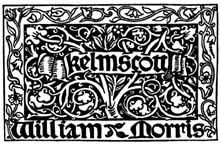http://ligiabouton.com/art/
The Adventures of William Morris Man creates a vivid fictional world by combining comic books imagery with Victorian wallpaper designs and traditional gold-leafing techniques. The superhero protagonist, clad in William Morris wallpaper, battles both the robot Owen Jones, who is armored in geometric designs, and an army of female furniture monstrosities who embody the excesses of Victorian fashion that Morris worked so hard to reject. Dialogue between these characters is drawn from Morris’s articles, lectures, and novels. Ultimately however, these graphic storylines disrupt the expectations of comic book conventions by juxtaposing domestic ornamentation with the ultramasculine superhero, and by defying narrative resolution and offering only unending conflict.
 William Morris (24 March 1834 – 3 October 1896)
William Morris (24 March 1834 – 3 October 1896)

 Owen Jones ((1809-1874)
Owen Jones ((1809-1874)
 Illustration from Joseph dreams of stars: page from The History of Joseph and His Brethren (1869).
Illustration from Joseph dreams of stars: page from The History of Joseph and His Brethren (1869).
Jones was a pivotal figure in the formation of the South Kensington Museum (later to become the V&A) through his close association with Henry Cole, the museum’s first director, and another key figure in 19th century design reform

The Adventures of William Morris Man creates a vivid fictional world by combining comic books imagery with Victorian wallpaper designs and traditional gold-leafing techniques. The superhero protagonist, clad in William Morris wallpaper, battles both the robot Owen Jones, who is armored in geometric designs, and an army of female furniture monstrosities who embody the excesses of Victorian fashion that Morris worked so hard to reject. Dialogue between these characters is drawn from Morris’s articles, lectures, and novels. Ultimately however, these graphic storylines disrupt the expectations of comic book conventions by juxtaposing domestic ornamentation with the ultramasculine superhero, and by defying narrative resolution and offering only unending conflict.
 William Morris (24 March 1834 – 3 October 1896)
William Morris (24 March 1834 – 3 October 1896)
 Owen Jones ((1809-1874)
Owen Jones ((1809-1874) Illustration from Joseph dreams of stars: page from The History of Joseph and His Brethren (1869).
Illustration from Joseph dreams of stars: page from The History of Joseph and His Brethren (1869).Jones was a pivotal figure in the formation of the South Kensington Museum (later to become the V&A) through his close association with Henry Cole, the museum’s first director, and another key figure in 19th century design reform





